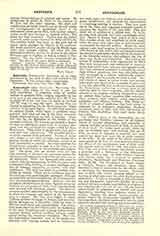

Araucanian (also ARAUCANS, MOLUCHES, MAPUCHES).—The origin of the word is not yet fully ascertained. A numerous tribe of warlike Indians in southern Chile, ranging originally (in the early part of the sixteenth century) from 36° S. lat. to about 42° S. lat., and from the Andes in the East (70° W. long.) to near the coast. Today they are limited to something like the North American “reservations” in the same region. In 1898, they were said to number 73,000, which figure is probably exaggerated. But they are one of the most numerous Indian tribes surviving, as such, in America. When first met by the Spaniards in the middle of the sixteenth century, the Araucanians formed a league of clans, or aillaragues, some forty in number, scattered over four geographical ranges called by them Butalmapu. Their mode of government was, and is even now, very rudimentary. The so-called ulmenes, or chiefs, exercise little authority. In case of iniininent danger, a war chief, or toqui, was chosen by a general council, at which the aillaragues would be as fully represented as possible. The toqui exercises his discretionary authority as long as a war lasts, or as long as he is successful, or the medicine-men support him. The latter, who are neither more nor less than sorcerers, or shamans are numerous among the Araucans and wield great power through their oracular utterances. When the Spaniards first came in contact with the Araucanians, in 1650, the latter were a sedentary tribe, dwelling in wooden buildings, and, like all Indians, constantly in conflict with their neighbors. The land was tilled on a modest scale, chiefly by women. There are no evidences that the Araucanians were exceptionally aggressive, although towards their northern neighbors, the Purumaucans, they entertained a special enmity. However, with the successive establishment of three Spanish towns by Valdivia the conqueror of Chile, their apprehensions were aroused, and hostilities ensued. The first encounters resulted unfavorably for the Araucanians, to whom the weapons and tactics of the Spaniards were a surprise. But they soon began to learn. Valdivia invaded the range of Arauco, and was completely defeated on December 2, 1553, his force of 500 men annihilated, and himself killed. The tactics then made use of by the Indians under the leadership of the toqui Caupolican and a young Indian named Lautaro, showed military qualities hitherto unobserved among the American aborigines. War with the Araucanians thereafter went on for nearly two centuries with varying success, and no impression was made upon the Indians, who displayed unusual grasp, perspicacity, and aptitude for improvement in everything relating to warfare. They soon made use of the horse and organized a cavalry capable of opposing the Spanish in the open field. They also made use of artillery in a limited way. In the beginning, their weapons had been exceedingly primitive. Spears or lances, with points of hard wood, flint, wooden clubs, and club-heads of stone constituted the arms with which they at first successfully encountered the Spanish soldiers. While the Araucanians made rapid progress in everything connected with the art of war, and in this way became formidable enemies to peaceable culture and the development of the Christian missions, they adopted the arts of peace very slowly and imperfectly. Maintaining the system of rudimentary social organization to which they were accustomed, and refractory to improvements that would have bettered their general condition, they continued a menace to everything around them without perceiving that they were being gradually enveloped by a culture intellectually superior, with which it was impossible for them to cope. Several treaties of peace, or rather truces, were successively made, and observed for a number of years, but it was only after 1792 that conditions became settled, the Araucanians continuing to occupy most of the territory held by them originally, and the Spanish colonies on its outskirts enjoying comparative quiet. At present these Indians maintain their autonomy_ They preserve their original social organization, polygamy, and religious customs. Still, being survivals of primitive conditions, they have either to disappear or to assimilate civilization. Smallpox decimated them in 1561, and other deleterious influences, like alcoholism, thin their ranks slowly but surely.
The religious ideas of the Araucanians are the pantheism and fetishism common to all Indians. Dread of natural phenomena, and especially of volcanic activity, so prominent in Chile, is the basis of their creed. To soothe such powers, which appear to surround man and threaten him on all sides, an army of shamans is required, and these control the inner and outer life of every member of the tribe. In the midst of the almost incessant wars carried on by them for more than two centuries, the efforts of the missionaries were of little avail. The Jesuits came to Chile in 1593, and twelve years later Vega, one of their number, had already written A grammar and a dictionary of the Araucanian language, which is lost. In 1606 Valdivia followed with similar works and a method of confession [Dahlmann, Sprachkunde and Missionen (Freiburg, 1901), 78, 79]. The foundation of Jesuit colleges at Valdivia, Arauco, and elsewhere, about 1594, furnished a base of operations for the efforts made to penetrate the Araucanian country. Nevertheless, in 1845, only twelve missions existed on the frontiers of what now might be called the Araucanian reservation. A tribe so saturated as this with fetishism and shamanism, apparently justified by a long series of military successes, inaccessible to progress in any other line than the art of war, will only become approachable in proportion as mental and moral degradation, resulting from isolation, causes it to weaken. Despite the almost insurmountable obstacles which the Araucanians opposed to Christianizing efforts, the Jesuit missionaries have for three centuries labored with untiring zeal to convert them.
AD. F. BANDELIER

